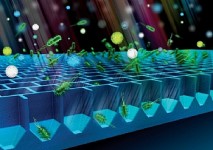Prof. Segal heads a multidisciplinary research team investigating the interface between materials science and biotechnology. The research of the group lies at the broad interface between nanomaterials science and biotechnology. This rapidly advancing research area is commonly termed as nano-biotechnology. Our research includes the basic study of structure-property relationships of nanomaterials and application of this knowledge in development of innovative materials and functional materials systems. We are interested in nanostructured materials such as porous Silicon and their interface with biological matter (e.g. biomolecules and living cells). Understanding these interfaces allows to rationally design biosensors for detection of biological and chemical toxins, new drug delivery platforms, and functional responsive materials.
Biosensors for Bacteria Detection
The task of rapid detection and identification of bacteria remains a major challenge in both medicine and industry. As current bacteria detection methods rely on lengthy laboratory-based techniques, there is an urgent need for developing biosensing platforms that will allow for rapid detection at point-of-care settings. Our lab designs different optical biosensors that can detect and monitor bacteria in real time.
Porous Si photonic crystals for bacteria detection:
The sensor is based a silicon chip with two-dimensional periodic structures of pores or pillars, in which the pore or pillar size is adjusted to fit the target bacteria cells. Bacteria capture within the microstructures induces changes in the zero-order reflectivity spectrum of the periodic structure, as shown below.

Schematic representation of the biosensing concept. Up left: bacterial suspensions are injected into a microfluidic channel containing a porous silicon chip. A white light is simultaneously illuminated on the chip surface, while reflectance spectra (up, right) are collected in real time by a spectrometer and analyzed, allowing bacterial response to be optically monitored in a noninvasive manner. Bottom, left: bacteria are introduced to the biosensor microstructure. Bottom, right: after several minutes, the bacteria are settle and capture into the microtopology. The capture of the bacteria on a silicon array chip induce a change in the optical signal.
By using scanning electron microscopy (SEM) and confocal laser microscopy (CLSM) the presence of the bacteria within the porous array can be confirmed. Moreover, by using these tools, we can monitor the concentrations and the growth of the bacteria within the porous Si chip, as shown below.

The capture and proliferation of E. coli bacteria on a silicon array chip showing the change in the optical signal as function of time. Scanning electron and confocal laser microscopy images depict the growing number of cells in the chip.
Porous Si photonic crystals for monitoring bacteria growth and adhesion:
With the increasing threat of antibiotic resistant bacteria, many precautions have been taken to prevent antimicrobial resistance from becoming the leading cause of death worldwide. In collaboration with physicians in neighboring medical centers and by advancing the system through microfluidics, we are developing new technologies for expedite antimicrobial susceptibility testing (AST). The group has shown in a recent publication in ACS Nano that biofunctionalized silicon micropillar arrays to provide both a preferable interface for bacteria networking and a simultaneous transducing element that monitors the response of bacteria when exposed to chosen antibiotics in real time. The chip-based technique allows to optically track the response of bacteria to clinically-relevant antibiotics and rapidly determine the if the bacteria is resistant or susceptible to a specific antibiotic.
Selected Publications:
- Leonard H., Halachmi S., Ben-Dov N., Nativ O., Segal E., Unraveling Antimicrobial Susceptibility of Bacterial Networks on Micropillar Architectures Using Intrinsic Phase-Shift Spectroscopy, ACS Nano, published online.
- Ude C., Ben-Dov N., Jochums A., Li Z., Segal E., Scheper T., Beutel S., Online analysis of protein inclusion bodies produced in E. coli by monitoring alterations in scattered and reflected light, Applied Microbiology and Biotechnology, 100 (9), 4147-4159 (2016).
- Massad-Ivanir N., Mirsky Y., Nahor A., Eitan Edrei, Bonanno-Young L.M, Ben Dov N., Sa’ar A., Segal E., Trap and Track: Designing Self-Reporting Porous Si Photonic Crystals for Rapid Bacteria Detection, Analyst, 139, 3885-3894 (2014).
- Mirsky Y., Nahor A., Edrei E., Massad-Ivanir N., Bonanno L.M., Segal E., Sa’ar A., Optical Biosensing of Bacteria and Cells using Porous Silicon-based Photonic Lamellar Gratings, Appl. Phys. Lett., 103 (3), 033702-033704 (2013).





